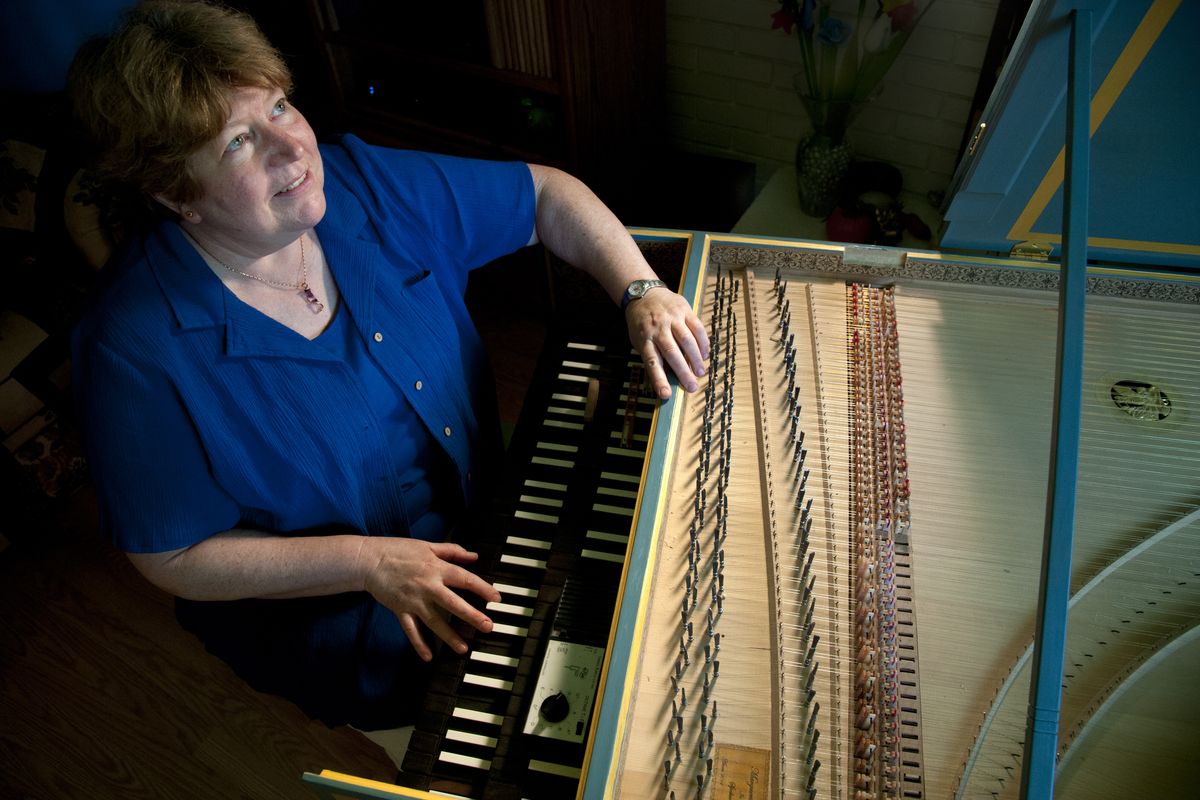Mij Ploger strikes a chord as Spokane’s lone harpsichord maker

Mij Ploger would have killed on one of those old network game shows.
You know, shows where a TV panel of celebrity B-Listers would try to guess someone’s offbeat occupation.
When they didn’t figure it out there’d always be a big reveal at the end.
“Ladies and gentlemen,” the announcer would say, “Meet Spokane’s top harpsichord maker!”
Of course, Ploger is likely Spokane’s only harpsichord maker.
“There are a few in Seattle,” she conceded. “But I’m the only one here.”
There’s nothing outside Ploger’s tidy North Side condo to give visitors a clue as to how the 64-year-old earns a living.
Ploger doesn’t advertise. Spokane is not exactly the hub of the harpsichord market. Go figure.
So Ploger relies on word-of-mouth and a website to reach the harpsichord-adoring world.
If you’re lucky enough to be invited into her living room, however, you can see for yourself what goes on here.
I stepped inside. There it was: an immaculate grand piano-shaped instrument that took me back to my college music history courses.
The harpsichord.
This one, painted blue and yellow, is a replica of an instrument you could buy in 1680.
Ploger has a bit of work left on the keyboard. After that this baby can be yours for $20,000.
If that sounds pricey please understand that it cost Ploger three months of her life to build it.
“I’d love to sell it in the region,” she said, adding that the model is designed more for teachers and students.
Ploger is warm and delightful. She’s full of humor and well aware of how quirky being a harpsichord builder sounds.
“It’s funny,” she said, “because so many people don’t know what a harpsichord is.”
Like many in my generation, I first paid attention to a harpsichord while listening to the Beatles’ “Rubber Soul” album. The harpsichord solo in the middle of “In My Life” still sounds amazingly cool.
The instrument was bigger than the Beatles during the Renaissance and Baroque eras of music. Think of the harpsichord as a forerunner to the piano only with fewer keys and another crucial difference.
Press a key on a piano. A felt hammer strikes a string.
Do the same on a harpsichord.
The string is actually plucked by a tiny quill that gives the harpsichord that unique, slightly metallic, ever-compelling tone.
Harpsichord players learn to massage the keys, explained Ploger, adding, “It’s all about caressing the keys.”
Ploger knows an awful lot about harpsichords considering she doesn’t play one.
That’s right. Ploger is a longtime clarinetist. She still plays in a local orchestra.
But 20 years of building and repairing harpsichords has acquainted her intimately with the instrument.
“What I need to know,” she said, “is how it feels and how it plucks and how it sounds.”
Ploger listens to Baroque music (J.S. Bach, say) while building “to get a sense of the music.” That said, “I like all music,” she added. “It just doesn’t matter.”
Ploger’s route to harpsichord maker would also stump a game show. She started out in food management and switched to the insurance industry, “working indoors and sitting a lot.”
Her life changed in 1994 while visiting her sister, Marianne, in Manchester, Michigan.
Her brother-in-law happens to be Keith Hill, a world-class harpsichord maker, extraordinary artist and expert in the reproduction of sound.
Since the early 1970s, Hill has built more than 400 instruments.
“I happened to be there. He happened to need some help cutting this and that.”
Her brother-in-law, she said, was impressed by how naturally she took to running power tools.
“Heck,” Ploger said she told him, “this is like running a sewing machine.”
In a few days Ploger had found her calling and Hill had found an apt pupil.
“Oh, yeah. He was all excited. He had somebody he could teach.”
And so it began.
Ploger’s apprenticeship lasted more than three years. In that time she learned the requisite skills. Harpsichords, she said, are traditionally made out of certain woods like boxwood, pine, beech, cherry, oak and usually spruce for the soundboards.
Some modern concessions must be made, however.
Cow bone, for example, is substituted for ivory, which can no longer be used for keys.
To date, Ploger has built 20 harpsichords and clavichords. She also builds and repairs keyboards for harpsichord players all over the world.
“Built from scratch, all by hand,” she said with pride.
The work takes place in Ploger’s basement. Her vast workshop is filled with an array of saws, woods, clamps, files and tools common to the woodworking trade.
With Pekoe, an orange tabby cat, by her side, Ploger is currently working on two clavichords. Much smaller than harpsichords, these early instruments sell for about $8,000 and are popular in Japan where space is often an issue.
“They become like babies to me,” she said of her instruments. “When I sell one I get sad because I don’t get to work on it anymore.”
The antidote, of course, is to start building the next one.
Ploger laughed.
“I’m kind of thinking I might retire when I’m 85.”